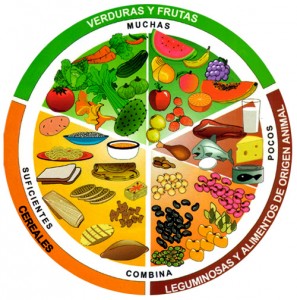Since it is summer (verano) and all the food is growing, people are out having bbqs and enjoying the weather, I thought today’s Spanish tip could be about food!
Food probably has the most variation among Spanish speaking countries. What one country calls “turkey” for instance can be many different words in different countries. However, here is a starting point.
Food –Comida, Alimento
Breakfast is desayuno
Lunch is almuerzo -or in Spanglish –lonche
Dinner is cena
Snack –Bocadillo, Refrigerio, Merienda, Tentempie -I’ve heard many words for snack, but no consensus on the standard. I usually use bocadillo
Tengo hambre =I’m hungry (Literal translation is “I have hunger”)
Tengo sed =I’m thirsty.
Comer = To eat. For example, “Me gusta comer” means “I like to eat” -if you like a certain food, you can add that food to the end. “Me gusta comer fresas” =”I like to eat strawberries”
Estoy lleno(a) –I’m full -When I lived in Mexico, everyone said this, but when I did, I was corrected by my host family to say “Estoy satisfecha” which is a more polite way of saying the same thing basically “I feel satisfied”.
Buen Provecho –I find it interesting that we don’t have an expression in English to say that we hope the food is good, that we enjoy it, that we have a good appetite for it. Instead we’ve borrowed from the French with “Bon Apetit”, or simply say “Enjoy”. But Buen Provecho is used at even the most casual of dining experiences in Latin America, so it is useful to know.
Many foods that have become folded into American dininig experience are known by their Spanish names -most commonly from Mexico such as burrito, taco, chimichanga, tortilla, jalapeño, churro, torta, salsa, tamale, rellenos, enchilada, and more. Many other countries such as Puerto Rico have different foods with different names. Sometimes they are the same food, but just called by a different name. Some foods in Puerto Rico are: pinchos, mofongos, tostones, pasteles (different than pastel in Mexico which is cake -these are closer to tamales), coquito (a drink), and more.
However, there are many other more common foods that may be good to know:
Bread =Pan
Egg = Huevo
Butter = Mantequilla
Fruit = Fruta
Apple =Manzana
Vegetable = Verdura, Vegetal
Zanahoria =Carrot
Grains =Granos, Cereales
Flour =Harina
Meat =Carne
Beef = Carne de res
Chicken =Pollo
Fish =Pescado (as opposed to pez or peces that are still swimming)
Milk =Leche
Cheese =Queso
Nut = Nuez
Candy/Sweets =Dulce(s)
Sugar =Azúcar
Postre = Dessert
For food, there is a lot to know. Everyone has to eat and there’s lots of variety! However, this is usually an area that most people learn just by doing, so don’t worry too much about it. If you have the basics, you’ll learn the foods (hopefully) by eating them with people who speak Spanish! And it will definitely be a little different wherever you learn it. ¡Buen provecho!


